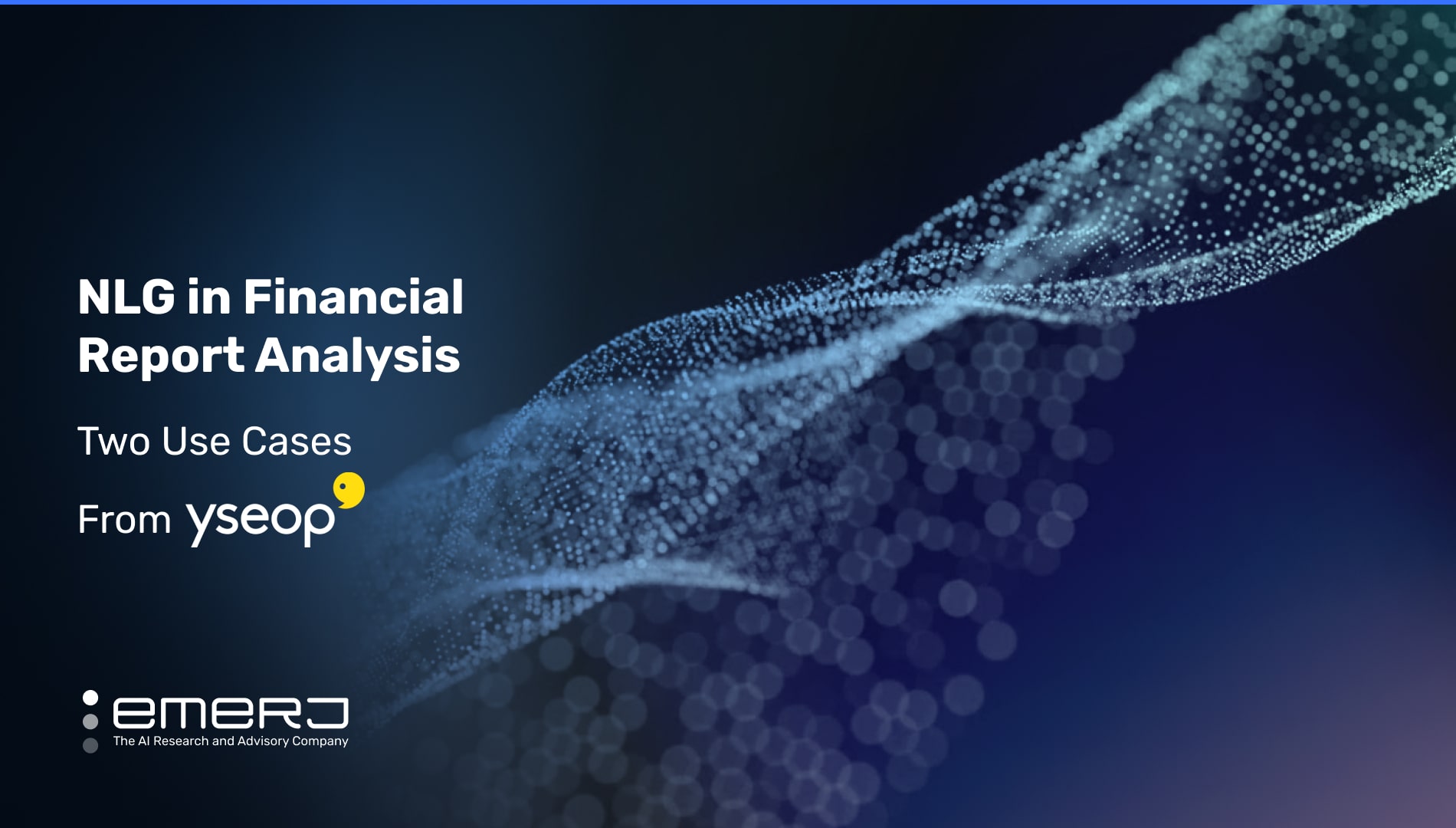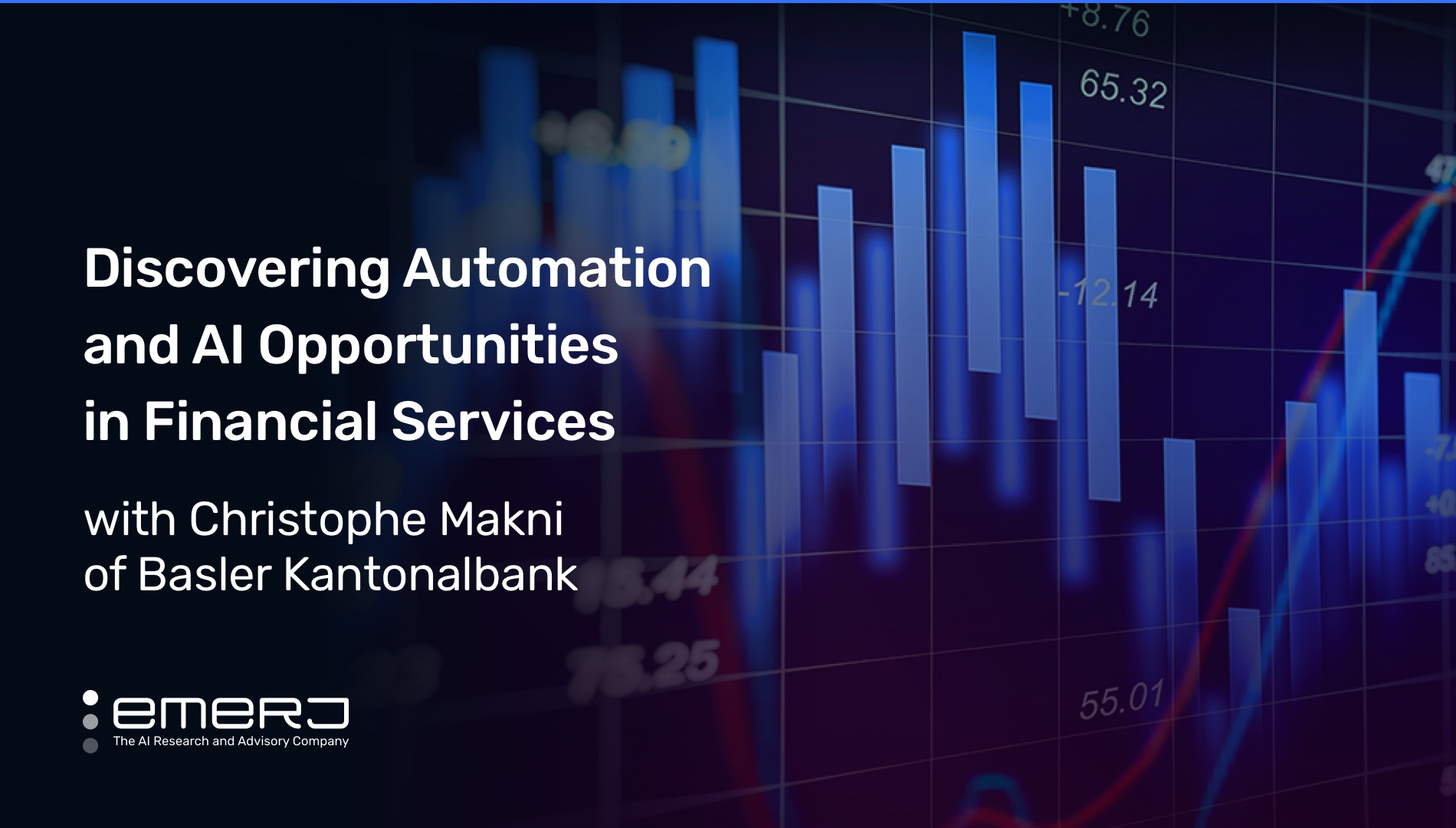NLG in Financial Report Analysis – Two Use Cases from Yseop
This article was initially written as part of a PDF report sponsored by Yseop and was written, edited, and published in alignment with our Emerj-sponsored content guidelines. Learn more about our thought leadership and content creation services on our Emerj Media Services page.
Regulators, stockholders, and customers demand that our businesses operate more agile, embrace today’s innovations, and free employees to focus on more valuable and strategic work. Internally, those demands inspire the goals and objectives thrust upon our finance leaders by their business partners and themselves.
Financial reporting traditionally requires many hours of manual work across departments and companies, resulting in considerable investments in time and money. Finance departments are always searching for new ways of accelerating their reporting, analysis, and decision-making processes to save capital.
AI-enabled solutions such as intelligent automation, natural language processing (NLP) and natural language generation (NLG) help companies automate some of the more time-consuming financial reporting tasks.
NLG is particularly useful to financial institutions for its ability to take extracted data and reorganize them based on data-informed insights. Doing so not only automates financial reporting but also enhances these reports’ quality.
In this article, we will examine two use cases involving NLG-enabled data gathering and report generation from Yseop:
- Business performance analysis: Analyzing month-end sales results for deeper insights to reduce time spent manually producing reports for leadership.
- Financial statement analysis: Training models to automatically produce balance sheets and other quarter and year-end financial reports.
Use Case #1: Business Performance Analysis
According to the case study report Yseop, nearly two thousand business analysts, financial controllers, and other key stakeholders at a large multinational company needed ten days at every month-end to gather and analyze the previous month’s results.
These analyses compared month-by-month results against budgets and forecasts across more than ten dimensions and over thousands of possible product, country, division, and channel combinations.
When analysts receive the results, they appraise all the details, identify facts and generate questions for follow-up and discussion. Traditionally, the quality of analysts’ insights and commentary depends exclusively upon their effort, knowledge, and experience.
According to the case study report, company leadership at a Yseop client wanted to make these reports more uniformly reliable by taking analyst skills out of the equation. Additionally, management sought to make the reports more actionable, clarify KPI comparisons over time, and identify the drivers that increased or decreased sales.
Yseop sources tell Emerj the company’s corporate finance team required that a dynamic, summarized analysis of all products across countries be built into the solution. Their requirements included:
- Consistent quality: All analyses had to be produced with the same quality, which could no longer depend on the analyst’s efforts and expertise.
- Time efficiencies in report production: The business performance analysis process needed to take much less time.
- Faster determination of key metrics: Stakeholders had to be able to quickly distill critical financial and performance insights so they could more quickly act on them.
To help the large multinational client achieve the above requirements, Yseop claims to have developed the following specs around any automated solution for this client:
- Delivery of concise business insights derived from real-time data spanning over 70 indicators
- API integration with the new data visualization tool
The case study report also claims Yseop customized its Intelligent Report Automation (IRA) solution to generate the company’s required multidimensional analysis and produce reliable reports showing sales performance and profitability results. Yseop then standardized the reports across groups, divisions, and departments to make more accurate and efficient comparisons.
Below is a brief video, just over a minute long, explaining the role of NLG in Yseop’s IRA platform:
Yseop’s solution IRA workflow consists of the following:
- Import the financial data
- Build the report model
- Preview the report
- Choose a narrative style
- Distribute the report
To reduce time spend, Yseop claims the solution integrates variation alerts and the ability to highlight said variations for later drill-down. The solution could reportedly isolate key variations within minutes, which provided analysts with additional context and insights for the company’s business units.
To minimize disruption to the business, Yseop reportedly worked closely with the company to roll out the solution in just eight weeks.
Yseop claims that the solution generated actionable insights for hundreds of stakeholders who relied on the monthly business performance analysis report. Among its contributions, they claim their NLG solution:
- Analyzed sales results across 70 indicators and 10+ dimensions
- Compared product performance across years and budgets
- Generated actionable insights and 100% accurate commentary
- Produced a 50% efficiency gain in report production
Yseop’s IRA solution allegedly saved the company both time and money. The company’s leadership noted savings from the hours and days analysts reclaimed through automating manual, error-prone tasks.
Use Case #2: Financial Statement Analysis
When closing the company books at financial reporting intervals (e.g., at quarters/fiscal year end), corporate accountants must often contend with internal and external complications. Delays, rushed reviews and inefficient workflows plague the closing of the books in all accounting departments.
AI technologies like NLG can augment the way accountants create essential financial reports, such as:
- Profit and Loss Statements
- Balance Sheets
- Statements of Financial Position
- Statements of Cash Flows
- Budget-to-Actual Analyses
For these reasons, a 2019 Yseop study with Omdia estimates that financial services will remain the most prominent use case for intelligent report automation until 2025. Below is a graph forecasting how much financial services organizations will spend on IRA over the next two years:
According to the case study report from Yseop, their client had four primary requirements for a solution automating workflows in producing their financial statement analysis:
- Production of better financial reports in less time.
- Ability to monitor financial results.
- Automatic generation of comments and follow-up points for 600+ financial indicators.
- The ability to provide drill-down reporting for high-level consumers of financial data.
To meet client requirements, Yseop claims their team took the following steps:
- Consulted with the client representatives, studied their financial close process, and identified parts of the process to be automated.
- Gathered the structured data for each financial report and loaded it into the Augmented Financial Analyst (AFA) Solution.
- Produced a workable model within two to three weeks, with customizable reporting achieved after two hours of data training.
- Following data training, the client distributed the models across company levels.
Yseop claims that a standard model was defined across subsidiaries, countries, and business lines, which enabled the client’s accountants and controllers to leverage the model where necessary and not in extenuating circumstances.
The case study report also claims Yseop’s project team collected feedback from clients and stakeholders to improve the model. Through Yseop’s built-in Feedback Loop tool, the client’s analysts adjusted the solution’s reporting commentary to reflect its human analysts’ natural writing styles and the organization’s voice using the solution’s embedded NLG technology.
Yseop claims its Augmented Financial Analyst solution delivers a range of financial reports to its client, including income statements, balance sheets, statements of change in equity, cash flow, statements of financial position, and notes to financial statements. In this particular use case, Yseop’s solution reportedly shortened the client’s reporting process. Reportedly, the devised solution shortened the process from days and weeks to minutes.
The claimed advantages of the solution were:
- Resolution of bottlenecks
- Increased operational efficiency
- More compliance confidence
- Fewer delays
- Better quality financial statement







